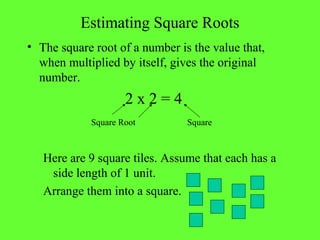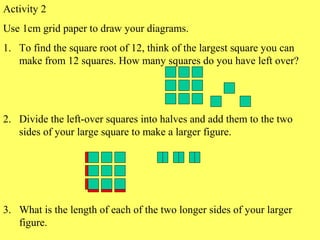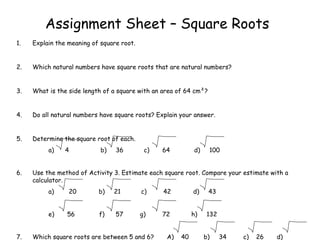Square root
- 1. Estimating Square Roots âĒ The square root of a number is the value that, when multiplied by itself, gives the original number. 2 x 2 = 4 Square Root Square Here are 9 square tiles. Assume that each has a side length of 1 unit. Arrange them into a square.
- 2. 1. What is the length of the side of the square? 2. Write a multiplication statement to describe the area of your square . X = 9 3. What is the square root of 9? 4. Repeat steps 1 to 3 for a) 16 tiles b) 25 tiles
- 3. Activity 2 Use 1cm grid paper to draw your diagrams. 1. To find the square root of 12, think of the largest square you can make from 12 squares. How many squares do you have left over? 2. Divide the left-over squares into halves and add them to the two sides of your large square to make a larger figure. 3. What is the length of each of the two longer sides of your larger figure.
- 4. âĒ What is your estimate of the square root of 12? âĒ Calculate the square of your estimate. Does the result equal 12? If not, explain why the result does not equal 12. âĒ Use grid paper to estimate the square root of a) 20 b) 6 c) 30 d) 42 Activity 3 Use 1 cm grid paper to draw your diagrams. 1. Suppose you want to find the square root of 18. What is the largest square that you can make from 18 squares? How many squares do you have left over? 2. You want to divide the left-over squares into pieces, and to fit the pieces along 2 sides of the larger square to make a larger figure. How should you do this? 3. What is the length of each of the two longer sides of your figure? 4. What is your estimate of the square root of 18? 5. Use steps 1 to 3 to estimate a value for the square root of each of the following. a) 5 b) 7 c) 22 d) 39 6. Use a calculator to check your estimates in question 5. Explain the difference between the square of your estimate and the number you began with. Use your diagrams in your explanations. 7. Use steps 1 to 3 to estimate a value for the square root of each of the following. Round your answer to 2 decimal places, if necessary. a) 11 b) 13 c) 27 d) 38
- 5. Assignment Sheet â Square Roots 1. Explain the meaning of square root. 2. Which natural numbers have square roots that are natural numbers? 3. What is the side length of a square with an area of 64 cmÂē? 4. Do all natural numbers have square roots? Explain your answer. 5. Determine the square root of each. a) 4 b) 36 c) 64 d) 100 6. Use the method of Activity 3. Estimate each square root. Compare your estimate with a calculator. a) 20 b) 21 c) 42 d) 43 e) 56 f) 57 g) 72 h) 132 7. Which square roots are between 5 and 6? A) 40 b) 34 c) 26 d)
- 6. Assignment Sheet â Square Roots 1. Explain the meaning of square root. 2. Which natural numbers have square roots that are natural numbers? 3. What is the side length of a square with an area of 64 cmÂē? 4. Do all natural numbers have square roots? Explain your answer. 5. Determine the square root of each. a) 4 b) 36 c) 64 d) 100 6. Use the method of Activity 3. Estimate each square root. Compare your estimate with a calculator. a) 20 b) 21 c) 42 d) 43 e) 56 f) 57 g) 72 h) 132 7. Which square roots are between 5 and 6? A) 40 b) 34 c) 26 d)





